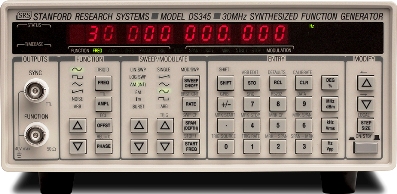
|
|
The SRS DS345 30 MHz function/ARB generator is a full-featured synthesized function generator that uses an innovative Direct Digital Synthesis (DDS) architecture. It generates many standard waveforms with excellent frequency resolution (1 µHz), and has versatile modulation capabilities including AM, FM, Burst, PM and frequency sweeps. It also generates arbitrary waveforms with a fast 40 Msample/s update rate. The SRS DS345 generates sine waves and square waves at frequencies up to 30.2 MHz, and triangle and ramp waveforms up to 100 kHz. The frequency resolution for all functions is 1 µHz. In addition to the standard waveforms, the unit also provides a wideband (10 MHz) white noise source. Both the function output and a TTL SYNC output are available through floating, front-panel BNC connectors. Both outputs have 50 O output impedances and may be floated up to ±40 V relative to earth ground. The amplitude of all function outputs is adjustable from 10 mVpp to 10 Vpp with 3-digit resolution, and can be displayed in Vp, Vpp, Vrms or dBm. In addition, standard TTL and ECL output levels can be selected. Additional useful connectors are provided on the rear panel. A trigger input is used to trigger arbitrary waveforms, modulation patterns, sweeps and bursts, while a TTL trigger output is provided to allow synchronization of external devices to sweeps and bursts. A sweep output generates a 0 to 10 V ramp synchronous with frequency sweeps. The sweep marker outputs allow specified portions of a frequency sweep to be highlighted on an oscilloscope. A 10 MHz rear-panel input allows the DS345 to be synchronized to an external timebase. A 10 MHz rear-panel output allows multiple SRS DS345 's to be phase locked. Features.1 µHz to 30.2 MHz frequency range. 1 µHz frequency resolution. Sine, square, ramp, triangle & noise. Phase continuous sweeps. AM, FM, PM & burst. 16,300 point arbitrary waveforms. 10 MHz reference input. RS-232 and GPIB. Option 01 GPIB, RS-232 and arb. software. Option 02 10 ppb OCXO timebase.
|